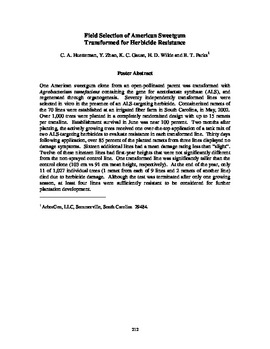| dc.contributor.author | Huetteman, C. A. | |
| dc.contributor.author | Zhao, Y. | |
| dc.contributor.author | Gause, K. C. | |
| dc.contributor.author | Wilde, H. D. | |
| dc.contributor.author | Parks, B. T. | |
| dc.date.accessioned | 2016-04-25T19:36:07Z | |
| dc.date.available | 2016-04-25T19:36:07Z | |
| dc.date.issued | 2003 | |
| dc.identifier | oksd_sf27_p212.pdf | |
| dc.identifier.citation | Huetteman, C. A., Zhao, Y., Gause, K. C., Wilde, H. D., & Parks, B. T., (2003). "Field Selection of American Sweetgum Transformed for Herbicide Resistance." In 27th Southern Forest Tree Improvement Conference, Stillwater, OK | |
| dc.identifier.uri | https://hdl.handle.net/11244/33703 | |
| dc.description.abstract | One American sweetgum clone from an open-pollinated parent was transformed with Agrobacterium tumefaciens containing the gene for acetolactate synthase (ALS), and regenerated through organogenesis. Seventy independently transformed lines were selected in vitro in the presence of an ALS-targeting herbicide. Containerized ramets of the 70 lines were established at an irrigated fiber farm in South Carolina, in May, 2002. Over 1,000 trees were planted in a completely randomized design with up to 15 ramets per transline. Establishment survival in June was near 100 percent. Two months after planting, the actively growing trees received one over-the-top application of a tank mix of two ALS-targeting herbicides to evaluate resistance in each transformed line. Thirty days following application, over 85 percent of the planted ramets from three lines displayed no damage symptoms. Sixteen additional lines had a mean damage rating less than �slight�. Twelve of these nineteen lines had first-year heights that were not significantly different from the non-sprayed control line. One transformed line was significantly taller than the control clone (103 cm vs 91 cm mean height, respectively). At the end of the year, only 11 of 1,027 individual trees (1 ramet from each of 9 lines and 2 ramets of another line) died due to herbicide damage. Although the test was terminated after only one growing season, at least four lines were sufficiently resistant to be considered for further plantation development. | |
| dc.format | application/pdf | |
| dc.language | en_US | |
| dc.relation.ispartofseries | Sponsored publication . . . of the Southern Forest Tree Improvement Committee ; no. 49 | |
| dc.rights | This paper is made available through open access and the auspices of the fair use doctrine for scholarly, educational and research purposes while recognizing the publisher already offers a free online version. The OSU Library�s intent is to offer access and preserve publications involving its faculty contributions. Contact the Digital Resources and Discovery Services at lib-dls@okstate.edu or 405-744-9161 for the permission policy on the use, reproduction or distribution of this material. | |
| dc.source | Proceedings of the 27th Southern Forest Tree Improvement Conference, volume 27, 2003. Editor, Craig R. McKinley. | |
| dc.title | Field Selection of American Sweetgum Transformed for Herbicide Resistance | |
| dc.type | text | |
| osu.filename | oksd_sf27_p212.pdf | |
| dc.type.genre | Conference proceedings | |
| dc.description.scopeandcontents | Papers and abstracts from the 27th Southern Forest Tree Improvement Conference held at Oklahoma State University in Stillwater, Oklahoma on June 24-27, 2003. | |
